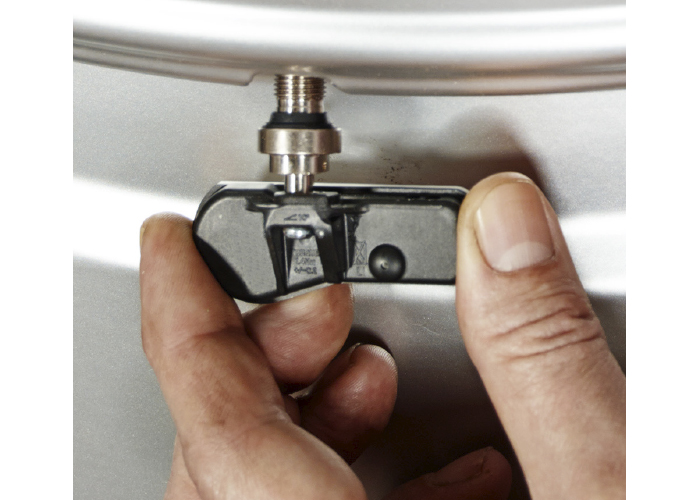Technicians like to see what they are diagnosing. The problem with diagnosing TPMS is you can’t see radio waves. TPMS sensors transmit electromagnetic radiation in organized patterns at a specific bandwidth to communicate information.
A TPMS sensor transmits a very-low power signal that goes in all directions. The waves are absorbed and reflected off the vehicle and environment. The antenna could be on the windshield, in the wheel well or in other locations.
TPMS sensor signals are low power and low frequency, with most sensors transmitting at 315MHz or 433MHz. Here is the problem: the radio spectrum the sensors use can be rather noisy with other devices like key fobs, garage door openers, and other TPMS sensors in the vicinity. These signals can interfere with the sensor’s information, like someone interrupting you mid-sentence.
To avoid the issues with radio interference, the future might be Bluetooth. For 2021, the Tesla Model Y started to use a sensor that communicates using Bluetooth protocols. Not much is known about the new system except that the sensors are currently available only through Tesla. Bluetooth also can be used for sensors that can detect the contact patch of the tire and wheel speeds that can factor in the rolling circumference.
When Do TPMS Sensors Transmit?
If a TPMS sensor transmitted all the time, it would not last very long. Most TPMS sensors will transmit when movement is detected through a simple accelerometer inside. If the wheel stops moving, the sensor will stop broadcasting after a programmed amount of time. But, once it is triggered, the sensor transmits on a predetermined interval set by the manufacturer. A sensor will immediately send a signal if it detects a sudden loss in pressure.
Mounted inside a tire assembly on valve stems or wheel rims, the sensors are usually powered by 3-volt lithium-ion batteries, but some use 1.25-volt nickel metal hydride batteries. Since the batteries are entombed, a dead or dying one requires the replacement of its entire sensor assembly.
When asked how long the sensor batteries will last, industry representatives provide a broad life expectancy range – five to 12 years and up to 100,000 miles are mentioned when addressing estimated life spans. The follow-up qualifier is that driving conditions, such as frequent on-off cycling of a TPMS, tire pressure sampling frequency and temperature extremes, will significantly shorten battery life.
The TPMS system will not turn the light on if a single transmission is not received. It takes multiple missed signals. The system knows that a missed or garbled message might be an external issue like a sensor on another vehicle transmitting at the same time or interference from the sensor being behind a brake caliper. It is like a misfire monitor – it sets a code only if the problem reaches a specific threshold.
Do TPMS Sensors Receive Radio Signals?
A sensor in the tire does not receive signals for the vehicle at 315 MHz or 433 MHz. Instead, they are “excited” or “pinged” by a signal at 125 MHz coming from a TPMS tool or antennas on the vehicle. The 125 MHz signal does not have any information. It just tells the sensors to transmit.
Some vehicles will ping the sensors when the vehicle is started, so the driver is alerted if they have a flat tire.
What is the sensor saying?
A TPMS sensor will typically transmit two or three pieces of information. First, it will broadcast its ID number, so the vehicle will know what sensor is transmitting. Second, the sensor will transmit the pressure of the tire. Third, the sensor might transmit the temperature of the sensor.
Now that we know what, when and how for TPMS sensor signals, it can be applied to real-life situations. For example, you now understand why you should perform relearns away from other vehicles and sources of electromagnetic interference like alarms and home appliances.
If you understand the signals are low power, you realize that rolling the vehicle forward a few feet will unblock the signal that could be blocked by a brake caliper or rotor.
If you comprehend when a sensor transmits, you can test the sensor with rapid deflation if a TPMS tool is not working.
Antennas
On most vehicles, there’s a single antenna for the four sensors. The antenna may be only for the sensors, or it could also be used for the keyless entry system. Why? The keyless entry system and TPMS sensors both transmit in the same radio frequency range of 315Hz to 430Hz.
Some vehicles have a dedicated module and antenna(s), while others have four antennas on the vehicle in the wheel wells. Certain Chrysler systems have three dedicated antennas, with the ignition switch module antenna acting as the fourth antenna. You probably won’t know until you pull up the wiring diagram. The signal from a TPMS sensor or key fob is a one-way conversation on most vehicles, whereby the keyless entry fob or TPMS sensor transmits and the vehicle receives. Yes, some aftermarket replacement sensors and key fobs can be programmed wirelessly, but this is a different set of signals and antennas.
When a TPMS sensor or key fob transmits, it is a very dull but fast (and important) conversation. It typically starts with an identification number that tells the module connected to the antenna to “listen up.” This code says the sensor or fob belongs to the vehicle. The next part of the transmission contains a command or status update on the tire pressure and temperature.
Just when you thought sensors do not receive signals, you’ll find a system that has transmitters in the wheel wells. Instead of waiting for the sensor to transmit on its own, a transmitter in the wheel well will send a signal to a sensor at around 125Hz. The signal tells the sensor to transmit a signal. The main advantage of this type of system is that the individual pressures can be obtained when the vehicle is stationary.
While this type of knowledge is not required to determine if a sensor is not functioning, it might prove to be essential when diagnosing a problem where data from one corner is not making it to the module.
Diagnostic Path
I believe in the “Test Before You Touch” method as a way to perform triage when assessing the initial customer complaint. This procedure can rule out inflation and dead sensor problems. But, if the problem can’t be resolved, it requires looking at the service information and technical service bulletins (TSBs).
Your TPMS tool is not just for relearns and programming sensors. Many of these tools can pull codes from the TPMS module through the OBDII connection. They can also be used to detect and measure the strengths of radio signals coming from sensors and the environment around the car.















